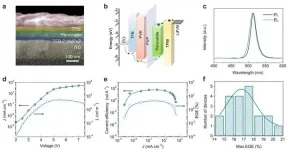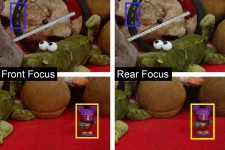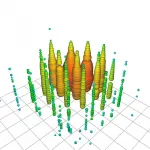(Press-News.org) Energy-efficient light-emitting diodes (LEDs) have been used in our everyday life for many decades. But the quest for better LEDs, offering both lower costs and brighter colours, has recently drawn scientists to a material called perovskite. A recent joint-research project co-led by the scientist from City University of Hong Kong (CityU) has now developed a 2D perovskite material for the most efficient LEDs.
From household lighting to mobile phone displays, from pinpoint lighting needed for endoscopy procedures to light source to grow vegetables in Space, LEDs are everywhere. Yet current high-quality LEDs still need to be processed at high temperatures and using elaborated deposition technologies -- which make their production cost expensive.
Scientists have recently realised that metal halide perovskites - semiconductor materials with the same structure as calcium titanate mineral, but with another elemental composition - are extremely promising candidates for next-generation LEDs. These perovskites can be processed into LEDs from solution at room temperature, thus largely reducing their production cost. Yet, the electro-luminescence performance of perovskites in LEDs still has room for improvement.
Led by Professor Andrey Rogach, Chair Professor at the Department of Materials Science and Engineering at CityU, and his collaborator Professor Yang Xuyong from Shanghai University, the team has found a kind of dimmer switch: they could turn one light emission from perovskites to a brighter level!
They worked with two-dimensional (2D) perovskites (also known as Ruddlesden-Popper perovskites) and succeeded to realise very efficient and bright LEDs, with best-reported performance on both current efficiency and external quantum efficiency for devices based on this kind of perovskites. This work has now put the perovskite LEDs close on the heels of current commercial display technologies, such as organic LEDs.
Their findings were published in the scientific journal Nature Communications, titled " END
Producing highly efficient LEDs based on 2D perovskite films
2021-03-10
ELSE PRESS RELEASES FROM THIS DATE:
Hip fracture outcomes worse during busy periods
2021-03-10
Hip fractures are serious, especially for the elderly. The operation can be a great strain, and 13 per cent of patients over the age of 70 do not survive 60 days after the fracture.
Their chance of survival may depend on how busy the surgeons are with other emergency procedures.
"When the operating room is busy, 20 per cent more of the patients die within 60 days after the operation," says Professor Johan Håkon Bjørngaard at the Norwegian University of Science and Technology's (NTNU) Department of Public Health and Nursing.
Surgeons can get especially busy during periods when the patient demand for surgery is high. In busy periods, hip fracture patients ...
Inspired by bone, new adaptive material strengthens from vibration
2021-03-10
Bone is not just a fixed material - it's a dynamic set of structures that can adapt their mass and strength based on the loads they must support.
Developing that sort of adaptive material has long been the dream of scientists. Now for the first time, scientists at the Pritzker School of Molecular Engineering (PME) at the University of Chicago have developed a gel material that strengthens when exposed to vibration.
Not only were scientists able to make the material 66 times stronger through vibrations, they were also able to strengthen only the areas exposed to movement. That sort of specificity could lead to new adhesives and ...
An electrically charged glass display smoothly transitions between a spectrum of colors
2021-03-10
Scientists have developed a see-through glass display with a high white light contrast ratio that smoothly transitions between a broad spectrum of colors when electrically charged. The technology, from researchers at Jilin University in Changchun, China, overcomes limitations of existing electrochromic devices by harnessing interactions between metal ions and ligands, opening the door for numerous future applications. The work appears March 10 in the journal Chem.
"We believe that the method behind this see-through, non-emissive display may accelerate the development of transparent, eye-friendly displays with improved readability for bright working conditions," says Yu-Mo Zhang, an associate professor of chemistry at Jilin ...
Bitcoin price boom 'locking in' vast energy consumption
2021-03-10
The cryptocurrency market has been abuzz as Bitcoin gains popularity with investors, reaching an all-time high of over $58,000 apiece in February. In a commentary published March 10 in the journal Joule, financial economist Alex de Vries quantifies how the surging Bitcoin price is driving increasing energy consumption, exacerbating the global shortage of chips, and even threatening international safety.
Theoretically, any computer with access to the internet and electricity can "mine" Bitcoin, a process to receive cryptocurrency by solving sophisticated mathematical equations. It is estimated that all miners combined make over 150 quintillion--that is 18 zeros following 150--attempts every second to solve the equation, according to numbers from January 11, 2021. Computational power ...
NIH researchers develop guidelines for reporting polygenic risk scores
2021-03-10
Scientists and healthcare providers are beginning to use a new approach for assessing a person's inherited risk for diseases like Type 2 diabetes, coronary heart disease and breast cancer, which involves calculating a END ...
Microbes may hold the key for treating neurological disorders
2021-03-10
When we think about the causes of neurological disorders and how to treat them, we think about targeting the brain. But is this the best or only way? Maybe not. New research by scientists at Baylor College of Medicine suggests that microbes in the gut may contribute to certain symptoms associated with complex neurological disorders. The findings, published in the journal Cell, also suggest that microbe-inspired therapies may one day help to treat them.
Dr. Mauro Costa-Mattioli, professor and Cullen Foundation Endowed Chair in neuroscience and director of the Memory and Brain Research Center at Baylor, discovered ...
Long-accepted theory of vertebrate origin upended by fossilized lamprey larvae
2021-03-10
Ottawa, March 10, 2021 - A new study of fossilized lampreys dating from more than 300 million years ago is challenging a long-held theory about the evolutionary origin of vertebrates (all animals with a backbone). The findings are published March 10 in the science journal Nature.
Lampreys are ancient, jawless, eel-like fishes that arose around half a billion years ago and they have long provided insights into vertebrate evolution. Now, scientists with the Canadian Museum of Nature, the University of Chicago and the Albany Museum in South Africa are reporting their analysis of dozens of tiny fossils that track the life stages and growth of ancient lampreys, from hatchlings to juveniles to adults.
Their results counter the established view that the blind, filter-feeding ...
Long-accepted theory of vertebrate origin upended by fossilized fish larvae
2021-03-10
A new study out of the University of Chicago, the Canadian Museum of Nature and the Albany Museum challenges a long-held hypothesis that the blind, filter-feeding larvae of modern lampreys are a holdover from the distant past, resembling the ancestors of all living vertebrates, including ourselves. The new fossil discoveries indicate that ancient lamprey hatchlings more closely resembled modern adult lampreys, and were completely unlike their modern larvae counterparts. The results were published on March 10 in Nature.
Lampreys -- unusual jawless, eel-like, creatures -- have long provided insights ...
Using artificial intelligence to generate 3D holograms in real-time
2021-03-10
Despite years of hype, virtual reality headsets have yet to topple TV or computer screens as the go-to devices for video viewing. One reason: VR can make users feel sick. Nausea and eye strain can result because VR creates an illusion of 3D viewing although the user is in fact staring at a fixed-distance 2D display. The solution for better 3D visualization could lie in a 60-year-old technology remade for the digital world: holograms.
Holograms deliver an exceptional representation of 3D world around us. Plus, they're beautiful. (Go ahead -- check out the holographic dove on your Visa card.) Holograms offer a shifting perspective based on the viewer's position, and they allow the eye to adjust focal depth to alternately focus on foreground and background.
Researchers have long sought ...
IceCube detection of a high-energy particle proves 60-year-old theory
2021-03-10
On December 6, 2016, a high-energy particle called an electron antineutrino hurtled to Earth from outer space at close to the speed of light carrying 6.3 petaelectronvolts (PeV) of energy. Deep inside the ice sheet at the South Pole, it smashed into an electron and produced a particle that quickly decayed into a shower of secondary particles. The interaction was captured by a massive telescope buried in the Antarctic glacier, the IceCube Neutrino Observatory.
IceCube had seen a Glashow resonance event, a phenomenon predicted by Nobel laureate physicist ...




